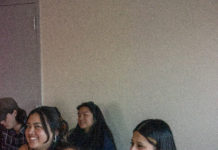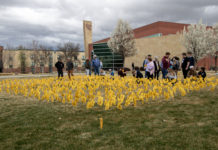At just past noon on Thursday, at the edge of the Grand Junction Regional Center, a trained and certified golden retriever laid down in a field, indicating a location of significance.
The retriever was a cadaver dog, handled by Kim Sadar,

Lucas Vader for The Criterion 
Lucas Vader for The Criterion
The cadaver dog teams were there because of Assistant Professor of Archaeology Dr. John Seebach, whose project to locate a lost Native American cemetery has been progressing for “a few years.”
In The Criterion article, History week shines light on historian pathways, Seebach explained that the Regional Center was once the Teller Indian School, where the Indians went to be “civilized.” Deaths of students were reported, but the school shut down in 1911. It was ravaged and stripped.
“All of the headstones were removed at one time, and we have no idea where that cemetery is to this day,” Seebach said at his History Week presentation on Feb. 8. “That’s how I got involved in this whole thing, because I’m part of this preservation attempt and one thing we’re attempting above all other things is to find the cemetery, fence it, and memorialize what happened here.”
When Sadar’s golden retriever sniffed out the grounds at the edge of the Regional Center and marked an area near the middle, both Sadar and the other handler, Bonnie Guzman, who had two dobermans on the scene, agreed that all the dogs detected something and that the area would need to be checked again in May.
Sadar and Guzman both said that the ground appeared to be too frozen for clear results at this time.
Before they searched the field of interest, they searched a different field for all of Wednesday and all morning on Thursday, but the dogs expressed little to no interest in that location, which was east of the Regional Center. Instead of slowing down and sniffing the ground, the dogs were running around and sniffing the air, looking for a place to start.
Even at that time, before Seebach, the dogs and the handlers moved closer to the school, Seebach was skeptical that the outer field was the lost cemetery, for it was purely based on rumors of “old-timers.”
“Honestly, I think it’s probably going to be closer to the school over there,” Seebach said, pointing toward the Regional Center.
The Teller Indian School’s chapel was closer to the second searched area, and according to Seebach, old articles from The Daily Sentinel had indicated that after funeral services, the people walked to the cemetery, though there was one case that mentioned the body had been taken by a horse and carriage. This indicated that the lost cemetery was close to the chapel, but not too close. The exact location of the old chapel is known, and the outer field they checked first was further out from the chapel’s location than Seebach figured the cemetery would be.
There was also a historic aerial shot of the Teller Indian School that showed a fence in the very corner of the picture, according to Seebach. The fence looked like it could belong to a cemetery.
Upon arriving at the second location, Seebach explained the limits of where the cemetery would have been, according to the picture of the fence, if indeed the fence was surrounding the cemetery. The dogs showed interest in the same area Seebach had indicated, with the same boundaries.

“We’re going to need to check this area again in May,” Guzman said after her doberman had stopped for an extended period of time to sniff the spot Sadar’s golden retriever had marked.
At least thirteen deaths have been documented, mostly by The Daily Sentinel, but Seebach suspects that there are more than that.
Seebach, the handlers, and the cadaver dogs are all more confident in the second area than they are in the first. On Wednesday, the dobermans found a section of the first location to be interesting, but the golden retrievers didn’t agree, so it was passed off as an anomaly.
As the entire boundary of the possible cemetery given by Seebach matched the boundary in which all the dogs were picking up a scent, the likelihood is higher than before that the lost Teller Indian School cemetery has been found.
“You can at least say that we’re out there trying,” Seebach said. “That’s better than anyone else has done in a hundred years.”
If they can get more than one dog to mark the location again in May, then the next step is ground-breaking radar, which will determine with more certainty that the lost cemetery is down there. Seebach will request state funding for that portion of the process, as he’s involved in a larger conservation effort.
“I will be consulting with all three Ute tribes on this project,” Seebach said. “There’s a guy coming from Southern Ute, he’ll be here [soon], and we’re going to tour the facility and talk about it then. Then, in May, late May, I’ll be talking to the other tribes, and through dialogue, we’ll see where we are on what needs to happen, if we hit.”
According to Seebach, the tribes prefer above everything else that the bodies are not disturbed. Therefore, a probable course of action in the case of the cemetery location being confidently determined with radar is memorialization.
The Regional Center is in the process of being evacuated and put up for sale. If the property isn’t privatized, there could possibly be public signage, according to Seebach.
“Everything’s just a maybe,” Seebach said, referring to the loose pieces in place regarding what happens if the dogs’ lead turns out to be true. No buyer has been determined for the property, which makes it nearly impossible to plan what happens in the case of the lost cemetery being found after more than a hundred years.

Lucas Vader for The Criterion 
Lucas Vader for The Criterion






